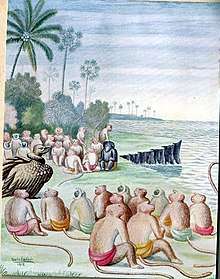Sampati
In Vedic scriptures, Sampati (Sanskrit: सम्पाति Sampāti) was the elder son of Aruṇa and Shyeni. He was brother of Jatayu.[1] He has the form of a vulture. According to Brahma Puran, Sampati is said to have a son named Babhru, who was swift and very well known. Sampati lost his wings when he was a child.
| Sampati | |
|---|---|
 Sampati meeting with Vanaras painted by Balasaheb Pandit Pant Pratinidhi | |
| In-universe information | |
| Family | Aruna (father) Shyeni (mother) Jatayu (brother) |
Sampati loses his wings
Sampathi and Jatayu, when young, used to compete as to who could fly higher in nilmatha. On one such instance Jatayu flew so high that he was about to get seared by the sun's flames. Sampati saved his brother by spreading his own wings and thus shielding Jatayu from the hot flames. In the process, Sampati himself got injured and lost his wings. As a result, Sampati lived wingless for the rest of his life.
Sampati in Ramayana
Sampati proved instrumental in Sita's search later on in the Ramayana. His role comes when the search party sent to the south, led by Hanuman with Angada, Jambavan, Nala and Nila exhausted, thirsty and depressed, reach the southern end of the land. They have the endless sea before them, and still no clue of Sita. Disappointed, everybody collapses on the sand, unable and unwilling to move or act any further. At this point, Sampati appears, openly talking about his fortune in so much easy meat arriving at his doorstep. At that moment, Jambavan laments out loud, comparing the morals of a vulture who would prey on the helpless with the vulture Jatayu, who defended Sita from Ravana.
The vulture froze as soon as he heard the word "Jatayu", and he asked to be told the story. After hearing of Jatayu's fate, a weeping Sampati reveals that he is Jatayu's brother, and that he hadn't contacted his brother in a long time. In gratitude for sharing the story, Sampati tells the party that Sita had been taken south to Sri Lanka.
The Griddhraj Parvat, situated in Satna district in Madhya Pradesh, is believed to be the birthplace of Sampati.[2]
References
- Dalal, Roshen (2010). Hinduism: An Alphabetical Guide. Penguin Books India. ISBN 978-0-14-341421-6.
- Skanda Purana
.jpg)